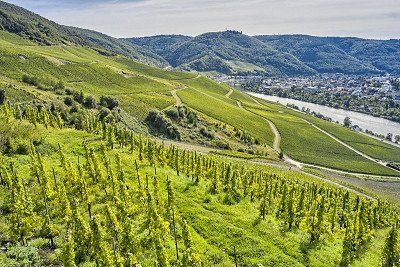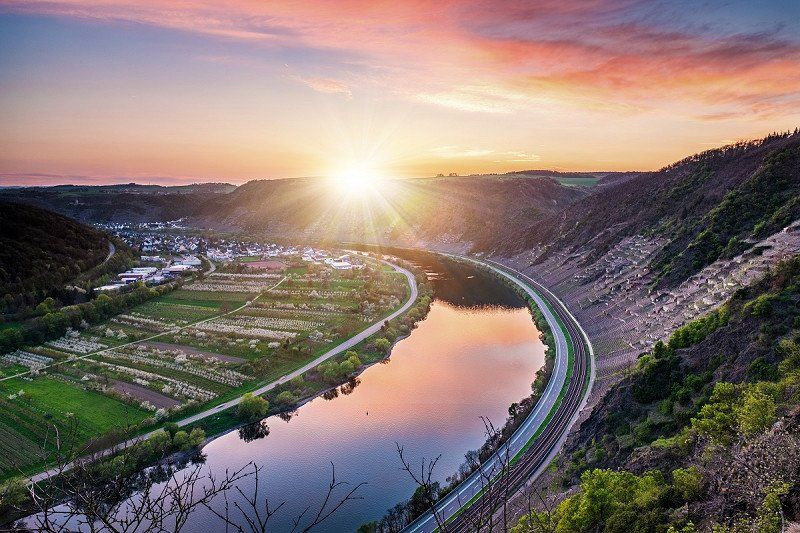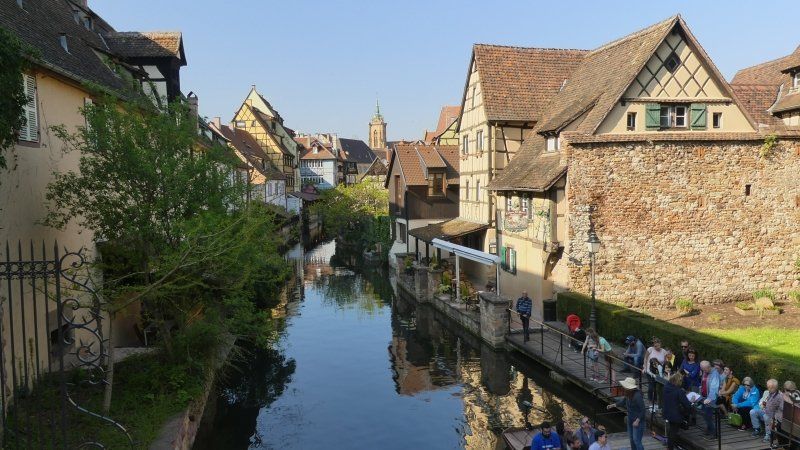The Moselle is popular with tourists in summer and autumn. However, the entire course of the Moselle is a scenic feast at any time of the year thanks to its narrow valleys, winding roads, beautiful architecture and picturesque towns. The best time to take a campervan trip along the Moselle is in spring when the attractions and campsites are not overcrowded yet. There is no need to rush here, instead all that is required of you is to relax and enjoy your surroundings. To help you on your way is a good tourism infrastructure, reflected by the many campsites and motorhome parks.
Contents
Where is the Moselle?Why visit the Moselle in spring?
Stopover tip #1: Koblenz
Stopover tip #2: Cochem
Stopover tip #3: Trier
Stopover tip #4: Metz
Stopover tip #5: The source of the Moselle

Where is the Moselle?
The Moselle is one of the most important tributaries of the Rhine. It rises in the French Vosges, a good hundred kilometres west of Freiburg im Breisgau. From there it flows north to the France-Luxembourg-Germany tripoint where it forms the border between Luxembourg and Germany. The Moselle now flows northeast from the Luxembourg border town of Wasserbillig and is now officially German. Moreover, the river, which has been quite straight up to this point, starts to twist and turn its way through the breathtaking landscape just after Trier. As a result, the actual distance of the river as well as the driving distance with a mobile home or campervan is more than twice the linear distance. The Moselle flows through Rhineland-Palatinate until it joins the Rhine in Koblenz after 544 river kilometres.
Please note: when taking a motorhome trip along the Moselle, you will cross national borders several times, depending on the route you choose – at least one to France. Freeontour's portrait of France summarises what you have to pay attention to when travelling through France with a motorhome or caravan. In addition to all the passengers' identity cards, you also need the original vehicle registration certificate of your mobile home.

Why visit the Moselle in spring?
The area around the Moselle offers a distinctive wine (growing) culture that stretches from Koblenz to Lorraine. However, it's precisely these factors that can have a slightly negative impact on summer and autumn holidays as it gets overrun with tourists quite quickly. The two riverside roads, which are partly separated from the water by small walls, are full of day-trippers, bikers and holidaymakers especially on good weather weekends and public holidays. The campsites and pitches benefit from this popularity and, therefore, from best occupancy rates. Simply put, the crowds in summer and autumn can at times put a damper on enjoying the Moselle.
When peace returns to the Moselle region in winter, it's the water level of the river that you have to keep an eye on. The German Moselle valley is narrow, so in turn high water has a quick effect: the roads to the southwest can get flooded quickly where the water overflows the banks. When most of the snow has melted in spring and the risk of flooding averted, you can still enjoy the tranquillity of the region before the many tourists start flooding the area (usually between March and May). Our tip: due to the narrow valley and flood risk, take a look also at pitches up on the hills when planning your stay. You will often only have to make a slight detour from the direct route, but they are usually larger and frequently cheaper.

Stopover tip #1: Koblenz
This motorhome trip on the Moselle begins in Koblenz, one of Germany's oldest cities. The tour here starts at kilometre zero because the Moselle river kilometres are counted in reverse. You should plan to stay at least two days in Koblenz. With a little over 100,000 inhabitants, Koblenz just about reaches big city status, yet this place is full of history. It all started with the Romans. The Deutsches Eck is a must for every visitor. A 37-metre-high equestrian statue of William I, the first German Emperor, watches over this promontory where the Rhine meets the Moselle. This statue and its location alone have an intense history: the original was inaugurated in a ceremony in 1897 and destroyed by artillery fire in March 1945.
Only the head of the old imperial monument remains today and can be viewed in the Middle Rhine Museum in Koblenz. Until 1993, the riderless plinth was preserved as a memorial to the German unification – symbolised by a flagpole with the German federal flag. On 2nd September 1993, a replica of the equestrian monument was erected on its pedestal – a date that also caused diplomatic controversy in 1993 as the inauguration fell exactly on Sedan Day, i.e. the day on which France surrendered to Germany, led by William I, in the Franco-Prussian war of 1870/71.
It's only a short walk from the Deutsches Eck through the Rhine park to get to the lower station of the cable car that runs over the Rhine. It was built in 2011 for the Bundesgartenschau (Federal Horticultural Show) in Koblenz and takes guests up to the Ehrenbreitstein Fortress on the right bank of the Rhine. Up here you can enjoy an impressive view far beyond the city limits. After getting back down, we recommend a stroll through the Old Town that boasts countless cafés, churches and shops.
Our tip: there are many campsites and RV parks in Koblenz, but one stands out due to its exceptional location right opposite the Deutsches Eck on the left bank of the Moselle, Knaus Campingpark. This campsite also has a separate motorhome park, with a panoramic view of the Moselle thrown in.

Stopover tip #2: Cochem
It's hard to single out just one must-visit stopover between Koblenz and Trier. Anyone embarking on this trip will realise this themselves once they see the many picturesque villages along the Moselle. One major highlight among the many highlights is most definitely Cochem. This town lies halfway between Koblenz and Trier and has just under 5,500 inhabitants. Moreover, its beautiful architecture is literally crowned by Cochem Castle, towering over the houses and the Moselle. According to many experts, it is one of the most beautiful castles in this region, which is known for its abundance of castles. The best thing about Cochem is that you can explore the city entirely on foot, although the climb to the castle is steep. After all, it is one of the highest hilltop castles along the Moselle.
If you don't feel liking walking up the hill for about 15 to 30 minutes, you can also take the Cochem Castle Shuttle Bus between mid-April and the end of October. Numerous architectural motifs for photographic memories as well as wine bars and cafés await in the town centre.
You can choose from three campsites and three motorhome parks of different sizes in and around Cochem, some of which are open all year round and others from mid-/late March. Our tip: if you plan on staying longer than a day, take a boat trip to the little town of Bernkastel-Kues up the Moselle – if only because this area of the Moselle looks much more romantic from the water than on foot.

Stopover tip #3: Trier
Augusta Treverorum – city of Augustus in the land of the Treveri. It was under this name that the history of Trier and thus the oldest city in Germany began two decades before year zero. Although Trier can only just be considered a big town, it still manages to outdo Koblenz when it comes to historical highlights. No tourist can come to Trier without visiting the Porta Nigra – the city gate of Augusta Treverorum built in 170 AD and a UNESCO World Heritage Site.
We also recommend staying in Trier for at least two days because Trier is home to a total of nine UNESCO World Heritage Sites, so there is a lot to see. Other UNESCO sites include the Church of Our Lady, the amphitheatre, the Imperial Baths, the Barbara Baths, the Roman bridge, the Basilica of Constantine, the cathedral as well as the Igel Column just outside of Trier. Seven of these nine World Heritage Sites date back to Roman times, which makes Trier the centre of antiquity. If you have never been to Trier before, it's best to use the Römer-Express train for a city tour to explore the town's most important landmarks.
Our tip: Luxembourg is only a few minutes' drive from the centre of Trier. If you have to refuel your motorhome or need coffee, stock up there as the prices are much lower.

Stopover tip #4: Metz
The next stage of the mobile home trip along the Moselle is in France, almost one hundred kilometres further up the river. Once again there is evidence of how fond the ancient Romans were of the Moselle. They turned Metz into a city in the first century and made it one of the most important trading centres within a radius of two hundred kilometres. But recent history has also left its mark in the capital of Lorraine: the fact that Metz was part of Germany between 1871 and 1918 led to an exciting architectural mix of Prussian/German and French stylistic elements that remained largely untouched by the wars.
Another architectural highlight is the Cathedral of Saint Stephen, a magnificent sacred Gothic building that was built between the 13th and 16th centuries. The Germans' Gate, which testifies to the military importance of the city as a fortress, also dates from around this time. It is the most impressive remnant of the city fortification, which for the most part is destroyed today. A good example of Prussian architecture is the phenomenal railway station in the Nouvelle Ville district, which was built according to the wishes of Emperor William II at the beginning of the 20th century. Another architectural highlight in Metz is Avenue Foch, which runs along the city walls of the Old Town. The buildings here illustrate just how fascinating the diversity and eclecticism of architectural styles at the beginning of the 20th century were.
We also recommend taking a walk through the centre of Metz – despite the cobblestones. You would probably miss out on quite a lot on a city bus tour, and not just with regard to the cafés and brasseries.
Our tip: if you want to stock up on fresh groceries, head to the Marché Couvert. This covered market on the square of the same name takes place every day except Sundays and Mondays. It is located in a huge building that was originally built as a bishop's palace.
Stopover tip #5: The source of the Moselle
You could easily extend this trip to three weeks. After Metz, Nancy is the next standout town near the Moselle with a breathtaking history. But now that you are near the end of your trip, you can go at a more leisurely pace. Take in the Lorraine villages, the rolling hills and the Lorraine plateau. Discover the unique way the locals express the French way of life that can only be found in this part of the country. The trip ends in the midst of lush green Vosges hills between the villages of Bussang and Urbès on Route Nationale 66: the source of the Moselle. In fact, it is no more than a trickle emerging from the mountain. And yet – as the past few kilometres have shown – it is the source of one of the most beautiful rivers in Europe.
If after this trip along the Moselle you still have a few days left, why not meander through Alsace on your way back home. Our route tip:



